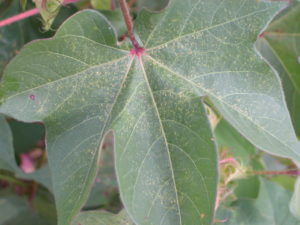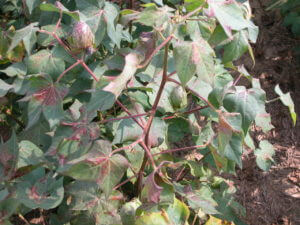
Two spotted spider mites are occasional pests in Tennessee cotton. Infestations are often most severe during hot and dry weather, in part because a fungus (Neozygites floridana) that attacks this species is not effective in these conditions. Immature and adult spider mites injure cotton by feeding on the contents of individual cells. They may feed on all plant structures but are most commonly observed on the undersides of leaves. Mites reduce the plant’s ability to produce photosynthate, and under severe infestations, cause premature defoliation and stunting. Spider mites disperse by crawling or by wind. Eggs are usually deposited on the undersides of leaves. Infestations often occur on field edges or in isolated spots and then spread across the field. Spider mites can complete a generation in as little as 4-5 days, so infestations may grow quickly under the right conditions. For more information visit the Cotton Insects Spider Mites Fact Sheet (W035).
The top surface of infested leaves may have white or yellow stippling/speckling. Older damage often appears as a reddening of leaves. Injury is often concentrated on the leaf near the petiole, around leaf veins and at leaf folds. Sample by observing the percentage of plants with symptoms of injury, and confirming the presence of spider mites. Look for mites on the undersides of leaves, and a 5-10 X hand lens is suggested to see mites and their eggs.
Treat when 30-50 percent of plants are affected and mites are still present. More than one application on a 4-5 day interval may be required depending upon the miticide selected and intensity of infestation.
Management options
| Insecticide (Trade Names) for SPIDER MITES | Lb Active Ingredient per Acre | Amount Formulation per Acre | Performance Rating |
| abamectin (Abba 0.15, Agri-Mek 0.15, Zoro 0.15) | 0.0047 - 0.019 | 4 - 16 oz | 7 |
| abamectin (Agri-Mek SC 0.7) | 0.0055 - 0.019 | 1 - 3.5 oz | 7 |
| bifenazate (Acramite 4) | 0.375 - 0.75 | 16 - 24 oz | 6 |
| emamectin benzoate (Denim 0.16)* | 0.01 - 0.015 | 8 - 12 oz | 6 |
| etoxazole (Zeal SC 2.88, Stifle SC 2.88) | 0.300 - 0.045 | 1.33 - 2 oz | 8 |
| fenpyroximate (Portal 0.4) | 0.05 - 0.075 | 16 - 24 oz | 8 |
| propargite (Comite II 6) | 0.94 - 1.69 | 20 - 36 oz | 6 |
| spiromesifen (Oberon 4) | 0.094 - 0.25 | 3 - 8 oz | 8 |
See label for specific use rates at different times of the season.
* These products may only suppress spider mite populations.
- Avoid unnecessary insecticide applications. Spider mite infestations are flared by the repeated use of some broad spectrum insecticides such as pyrethroids and acephate.
- Spider mite infestations often start and end suddenly. Population crashes following a rain are sometimes observed, and irrigation or frequent rainfall generally reduces the impact of spider mites on yield.
- Equipment, sweep nets, or people can spread spider mites.




